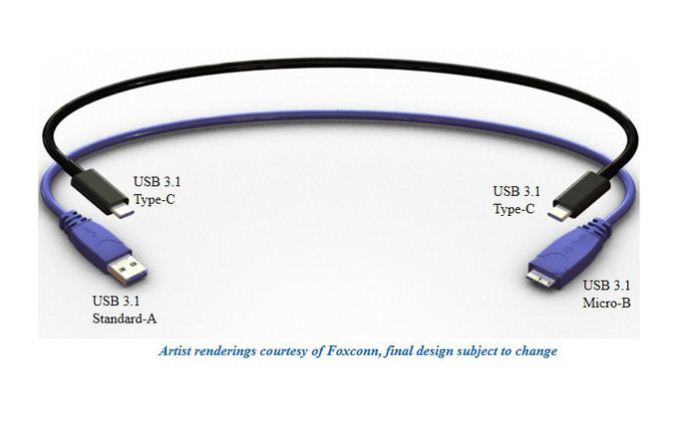USB-IF Publishes First Type-C Connector Renderings
by Ryan Smith on April 2, 2014 7:30 PM EST
The last time we talked to the USB Implementers Forum (USB-IF), the governing body for USB, it was back at CES 2014. At the time the USB-IF was showing off their plans for USB 3.1, an updated version of USB set to double USB’s throughput from 5Gbps to 10Gbps. The USB-IF was also using CES to discuss their plans for the new Type-C connector, a small, reversible connector that would be designed to replace the existing standard (large) and micro connectors on hosts and devices alike, while also doing away with the frustrations of trying to properly orient a USB plug the first time. However at the time the USB-IF was still finalizing the design for the Type-C connector, so while they could discuss their plans they didn’t have a final connector to show off.
Catching up to today, while the USB-IF still hasn’t finalized the Type-C connector, they have for the first time released renderings of what they’re expecting the connector to look like. Since it’s intended to replace standard and micro devices alike, it comes as no surprise then that the Type-C connector looks a lot like today’s USB 2.0 Micro-B connector, with concessions made to make the connector reversible and to house the additional pins that are necessary. We’re told the connector is 8.3x2.5mm, which makes it larger than USB 2.0 Micro-B, but still smaller than the wider Micro-B connector for USB 3.0.

Images Courtesy The Verge
Meanwhile in the USB-IF’s rendering of the socket itself, we can clearly see that Type-C will still be using tongues in the socket, with the pins once again organized around the tongue. There had been some speculation that Type-C would do away with tongues and be similar to Apple’s Lightning connector, but this is clearly not the case.
As exemplified by the USB-IF’s render and in their previous statements, the USB-IF is intending for this connector to be a long term replacement for hosts and devices alike. So while we’ll still see Type-A connectors on hosts for some time, the idea is to eventually replace those with Type-C connectors, just as how devices will move to Type-C. The ultimate idea being that once that transition is complete both hosts and devices will use the same connector, doing away with the differing ports and asymmetrical cables of today.
The USB-IF is anticipating completion of the Type-C specification in July, which means we could be seeing Type-C cables and design by the end of this year.
Source: CNET










24 Comments
View All Comments
thomas-hrb - Wednesday, April 2, 2014 - link
Looks good. IMHO the tongue is susceptible to damage; especially during the normal wear and tear of plugging in the cable on a mobile device. Is there any mention on how much power this connector will be able to transport? 100W would be a good start no?Folterknecht - Wednesday, April 2, 2014 - link
http://www.computerbase.de/2014-04/usb-3.1-type-c-...up to 100W with special cables/connectors
thomas-hrb - Wednesday, April 2, 2014 - link
Thanks @Folterknecht. I would hope that supporting 100W is part of the requirement for all cables not just for special cables and connectors.DanNeely - Wednesday, April 2, 2014 - link
It's not clear from the Intel slide deck if the higher power options will need different cables, but I think the connector may be standard but that the cable will need to be more robust to support the higher voltage/current levels.http://www.computerbase.de/bildstrecke/56518/5/
http://www.computerbase.de/bildstrecke/56518/6/
markus_b - Thursday, April 3, 2014 - link
No, 100W is an illusion for such a small connector. It may be able to bear 2Amps (10W@5V). The high power USB spec allows for 12V, which gives more headroom.I find it a pity, that the high power USB spec limits itself to 12V. I would like to see up to 48V for more power while retaining small/thin cables.
Xajel - Thursday, April 3, 2014 - link
Why Illusion ? there was talks about supporting 100W on regular USB cables by using higher voltages instead of high amperage, considering current quality USB cables can handle 2.1A, then working with 48-50V is enough to have 100W... this will work well for a lot of applications including laptops, tablets, external displays, external storage... the specifications require the device to negotiate first and request how much wattage is required so the power will be delivered :)The only requirement I see will be improved insulation for the higher voltage, though it will be easier as it will be DC and not AC
DanNeely - Thursday, April 3, 2014 - link
The 100W version is the power spec is 5A @ 20WDIYEyal - Friday, April 4, 2014 - link
20V*CZroe - Thursday, April 3, 2014 - link
That's why I'd prefer that the easily replaceable cable have the tongue instead of the device.phoenix_rizzen - Thursday, April 3, 2014 - link
Or get rid of the tongue completely. The contacts should be on the outside of the cable plug and the walls of the socket.I've broken the tongue off phones and desktops. But I've never broken a headphone jack or plug.
Tongues and pins are stupid. Say what you will about apple, they've at least figured this out.